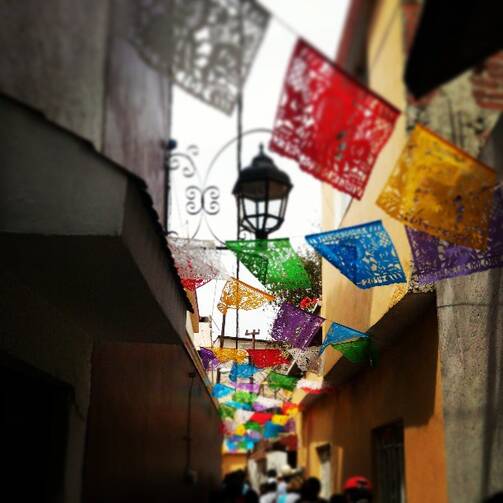For the last several years, the art museum in my city has collaborated with local artists to hold a Day of the Dead exhibition. Friday the 13th seemed a good day to see it, particularly as I had just returned from visiting a friend who several months ago had lost her husband suddenly and unexpectedly. She had written me before I saw her and shared she was struggling to find out how to have a relationship with him now that he was dead. She’d had one while he was alive; now that he was gone she wondered how to continue it.
November is a good month for mulling over such questions. As I’ve become more conscious of that, I like the month more because of it. The liturgy for All Souls Day is one of my favorite liturgies of the year. I feel lucky to go to a church that celebrates it beautifully. It wasn’t that long ago that I ignored the occasion entirely. My first glimpse of how meaningful it can be was in Europe when I attended an All Souls service in the medieval chapel adjoining an Augustinian cloister. Dark had fallen outside. Votive candles had been placed round the grounds of the cloister. They glowed in the darkness and lit the way to the chapel. The triduum of Allhallowtide seemed truly hallowed.
I thought it was my age that made me more enthusiastic about these festivals commemorating the dead, but actually the Day of the Dead seems popular with people of all ages. The ghoulishness of both it and Halloween does not seem to repel children. If anything, it’s the macabre elements that often seem to delight them.
This year’s Day of the Dead altar at the museum focused on the four elements. A skeleton made of beautifully cut white paper—an example of Papel picado, a Mexican craft I’d never heard of before—hung suspended over four sand paintings depicting earth, wind, fire and water. Around this altar people had written the names of the dead they wanted to honor on paper cutouts of the same shapes as the four symbols in the sand paintings and in the same bright colors of orange, purple, red and pink. Tables in the corners of the room furnished with paper and pens gave people more information about the particular element and let them sit down to write down the names of those they wanted to remember and to pen a message to them.
This is the fifth year the museum has held a Day of the Dead exhibition, and I think it’s turning into an annual event because so many people like and respond to it. My recently widowed friend is not the only one wanting to continue a relationship with someone who has died. It seems a universal desire. Memorials, mausoleums, parks and buildings named after someone who has died, college scholarships and professorships given in someone’s honor, all reflect a desire to remember those loved and lost.
Keeping Faith
A year or so ago I interviewed Tracy McClard, a woman who had started an organization called Families and Friends Organizing for Reform of Juvenile Justice (FORJ), which is dedicated to ending the practice of placing juveniles in Missouri in adult jails and prisons. In the United States, 10,000 children under the age of 18 are incarcerated in adult jails and prisons, and about 100,000 juveniles are handled by the adult criminal justice system annually. In Missouri, children as young as 12 years old can be certified as adults and placed in adult jails. Recently, a case involving an 8 year old who might be prosecuted as an adult has drawn national attention.
The situation of children who are tried as adults and sent to adult prisons is tragic, one of many practices in the criminal justice system in desperate need of reform. According to the National Justice Juvenile Network (NJJN), prosecuting children as adults does not improve public safety and increases the likelihood of youths reoffending. A 2007 study by the Centers for Disease Control and Prevention found that youth involved in the adult system are 34 percent more likely to commit crimes than children who have done similar crimes but remain in the juvenile justice system. The NJJN reports that youth are the most vulnerable to rape of all prison inmates; sending them to adult prisons rather than juvenile detention facilities also increases their risk of suicide.
Mrs. McClard started FORJ after her 17-year-old son Jonathan took his life in prison seven weeks after he was sentenced to 30 years in a maximum-security prison in Charleston, Mo. He had shot but not killed his girlfriend’s new boyfriend who he believed was mistreating her.
Unconsciously, I had held a stereotype in my mind of mothers whose teenage sons died in prison, and Tracy McClard did not fit it. She was a lovely woman, not noticeably downtrodden, and she had quit her job as a special education teacher to devote herself to the organization she started. The acronym FORJ stands not only for Families and Friends Organizing for Reform of Juvenile Justice but also “for Jonathan,” she told me, and I realized this was her way of keeping her son present in her life even in death.
Righting a social wrong, pursuing a cause, seems a fine way of keeping faith with someone gone, but there are many other ways people discover. Recently, I learned that my high school French teacher, who outlived her husband by a good 20 years, wrote him a letter every day after he died. She was French, strict and very demanding as a teacher. Only later after I graduated from college and saw her under different circumstances did I realize that in addition to being intelligent and thoughtful, she was shy and reserved. In high school, I had seen her as formidable. As an adult, I realized she might have found her students occasionally daunting as well.
Our relationships with people we’ve known in the past change just as do our relationships with those we know now. I used to think of life and death in binary terms. Alive/dead. Here/gone. But the borders between life and death are more permeable than I once thought, and our moments of communion with the dead are to be treasured just as we treasure our communion with those who are living.








